Grădinăritul de la meșteșug la zorii industriei horticole la București
Bucharest’ Gardening from Craftsmanship to the Dawn of Horticultural Industry
Author(s): Ileana KisilewiczSubject(s): Architecture, Economic history, Local History / Microhistory, 19th Century
Published by: Editura Academiei Române
Keywords: gardening; horticulture; Louis Leyvraz; Charles Faraudo; Charles (Carol) Faraudo; Louis Faraudo; Arnold Faraudo; Belu cemetery; București;
Summary/Abstract: The landscaping of private properties, valorizing the vacant lands and their transformation into public gardens, and the recreation of the boulevards with vegetation strips, in a Parisian manner, were growing in Bucharest in the nineteenth century. In this activity, one also notices the entrepreneur of horticulturists Louis Leyvraz and Charles Faraudo, of Swiss origin. They contribute to increasing the attention of the communal administration to arrange public spaces. Until the beginning of the nineteenth century, gardening was considered an artisanal activity that required manual skills and botanical knowledge. The results depend on the presence of a remunerated professional and the vagaries of the time, specific to the climate of the Romanian space.The development of the taste for the green universe is gradually transferring from private spaces owned by the members of society who were conducting prosperous businesses to the public ones financially supported by the Bucharest Town Hall and the Communal Councils setting up new parks. The fruitful activity of the two Swiss, established in the Blue sector of Bucharest, ensured prosperity for the enterprise for almost 100 years, extending its greenhouses and croplands, specializing in the production of trees, ornamental plants and import of plants for increasingly demanding customers. Even if the nationalization led to the transformation of the Faraudo Greenhouses into the Bucharest Communal Greenhouses, the activity remained equally productive and appreciated until the end of the twentieth century.
Journal: Historia Urbana
- Issue Year: XXX/2022
- Issue No: 30
- Page Range: 209-226
- Page Count: 18
- Language: Romanian
- Content File-PDF

